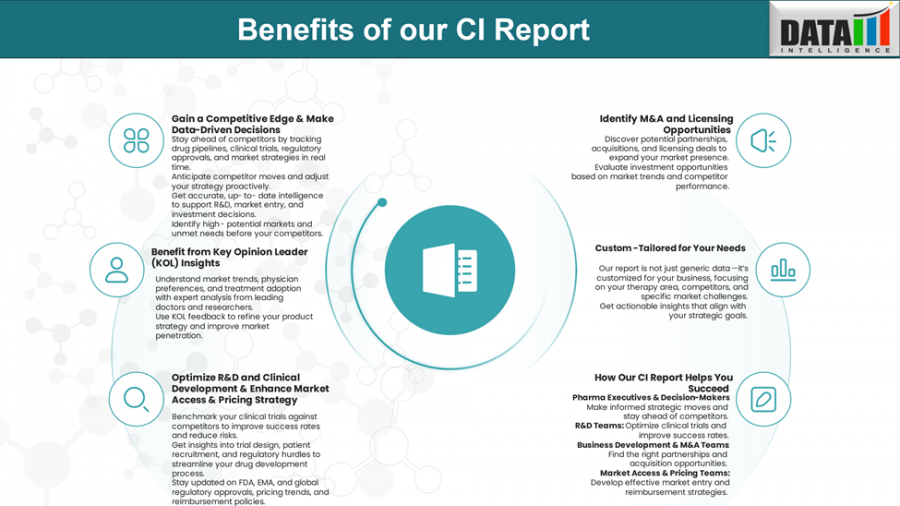
Inflammatory Bowel Disease (IBD): Deep-Dive CI Insights & Target Opportunity Landscape | DataM Intelligence
AUSTIN, TX, UNITED STATES, June 4, 2025 /EINPresswire.com/ -- A Target Opportunity Profile (TOP) outlines the characteristics of an ideal therapeutic candidate for inflammatory bowel disease, based on prevailing unmet needs, existing treatment limitations, and emerging competitive dynamics. With IBD treatments evolving rapidly, identifying and benchmarking against the ideal profile can help stakeholders better position their assets for long-term success.
Ideal Drug Attributes and Current Gaps
In terms of efficacy, an ideal IBD therapy should induce and sustain remission rates exceeding 50–60%. Current biologics and oral treatments typically reach remission rates of only about 30–40%, leaving a substantial portion of patients either non-responsive or at risk of relapse.
Download Free CI Sample Report: https://www.datamintelligence.com/strategic-insights/sample/inflammatory-bowel-disease-ibd
When it comes to safety, the optimal treatment should offer minimal risk of serious infections, malignancies, or cardiovascular events. However, many existing therapies, particularly immunosuppressants and Janus kinase (JAK) inhibitors, have significant safety concerns, limiting their long-term use and necessitating ongoing monitoring.
Onset of action is another critical attribute. Most currently approved drugs take between 6 to 12 weeks to show therapeutic effects. In contrast, patients dealing with acute disease flares would greatly benefit from a fast-acting drug that can begin alleviating symptoms within 1 to 2 weeks.
The durability of response is a challenge for many existing therapies. Agents such as anti-TNFs and some JAK inhibitors show good initial efficacy, but many patients eventually lose response over time, necessitating therapy changes or combinations.
Administration route also plays a significant role in patient adherence and quality of life. The ideal IBD therapy would be available as an oral formulation or a long-acting subcutaneous injection. However, many existing treatments still require frequent infusions or injections at healthcare facilities, which adds to the burden on patients and providers.
On the mechanism of action front, there is growing interest in novel targets beyond traditional TNF, IL-12/23, and JAK pathways. Patients who fail existing biologics have limited options, underscoring the need for therapies with new mechanisms such as TL1A antagonists, S1P modulators, and microbiome-based approaches.
For monitoring, current disease management relies heavily on colonoscopy, which is invasive, costly, and inconvenient. An ideal solution would be non-invasive biomarker-based monitoring tools (e.g., stool or blood tests) that could reliably track disease activity and treatment response.
The ability of a therapy to be used in combination is another advantage. The most effective future treatments should be safe to combine with other agents, without exacerbating immunosuppression or causing serious drug-drug interactions.
From a cost and accessibility standpoint, affordability remains a major barrier, especially for biologics and new oral therapies. The ideal product should have competitive pricing, broad insurance coverage, and available biosimilar or generic alternatives to ensure patient access across geographies.
Book Your Free CI Consultation Call: https://www.datamintelligence.com/strategic-insights/ci/inflammatory-bowel-disease-ibd
Benchmarking Current & Emerging Therapies Against the Ideal Profile
Current anti-TNF biologics like adalimumab and infliximab provide moderate efficacy with reasonable safety, but they have a slow onset of action and require injection or intravenous administration. They also do not represent a novel mechanism, limiting their utility for patients who fail to respond.
IL-12/23 inhibitors such as ustekinumab show higher efficacy and a more favorable safety profile, though they are still administered via injection and do not represent a new mechanism. IL-23 specific agents like risankizumab and guselkumab offer promising remission rates and sustained response, with improved safety, but still fall short of oral convenience and are only partially novel.
Integrin inhibitors like vedolizumab (Entyvio) are known for gut-selective action and fewer systemic side effects, making them safer for long-term use. However, their relatively slow onset of action and intravenous delivery limit convenience.
JAK inhibitors such as tofacitinib and upadacitinib deliver rapid symptom relief and the benefit of oral administration. However, safety issues including infection risk and cardiovascular concerns have led to regulatory warnings, restricting their use in certain patient populations.
S1P modulators like ozanimod and etrasimod offer a novel mechanism with the advantage of oral delivery. They have moderate efficacy and a generally acceptable safety profile but may still have slower onset compared to JAK inhibitors.
Among the most promising emerging therapies, anti-TL1A antibodies such as duvakitug (developed by Teva and Sanofi) are expected to bring high efficacy with good safety in biologic-refractory patients. Their novel mechanism offers hope for patients unresponsive to current biologics, although they are still in clinical development.
Microbiome-based therapies like SER-287 and VE303, currently in early to mid-stage trials, aim to modulate gut flora to treat IBD. These offer a completely different therapeutic avenue and are expected to be administered orally, though their efficacy and speed of action remain to be proven.
In the future, gene therapies and cell-based approaches are under exploratory research, potentially offering long-lasting remission or even a functional cure. While still theoretical, such treatments could address many of the existing gaps in efficacy, durability, and disease modification.
Read More CI RDs:
1. huntingtons disease pipeline momentum biotech next frontier
2. hunter syndrome mucopolysaccharidosis type ii mps ii
Sai Kiran
DataM Intelligence 4market Research LLP
877-441-4866
email us here
Visit us on social media:
LinkedIn
X
Distribution channels: Healthcare & Pharmaceuticals Industry
Legal Disclaimer:
EIN Presswire provides this news content "as is" without warranty of any kind. We do not accept any responsibility or liability for the accuracy, content, images, videos, licenses, completeness, legality, or reliability of the information contained in this article. If you have any complaints or copyright issues related to this article, kindly contact the author above.
Submit your press release
